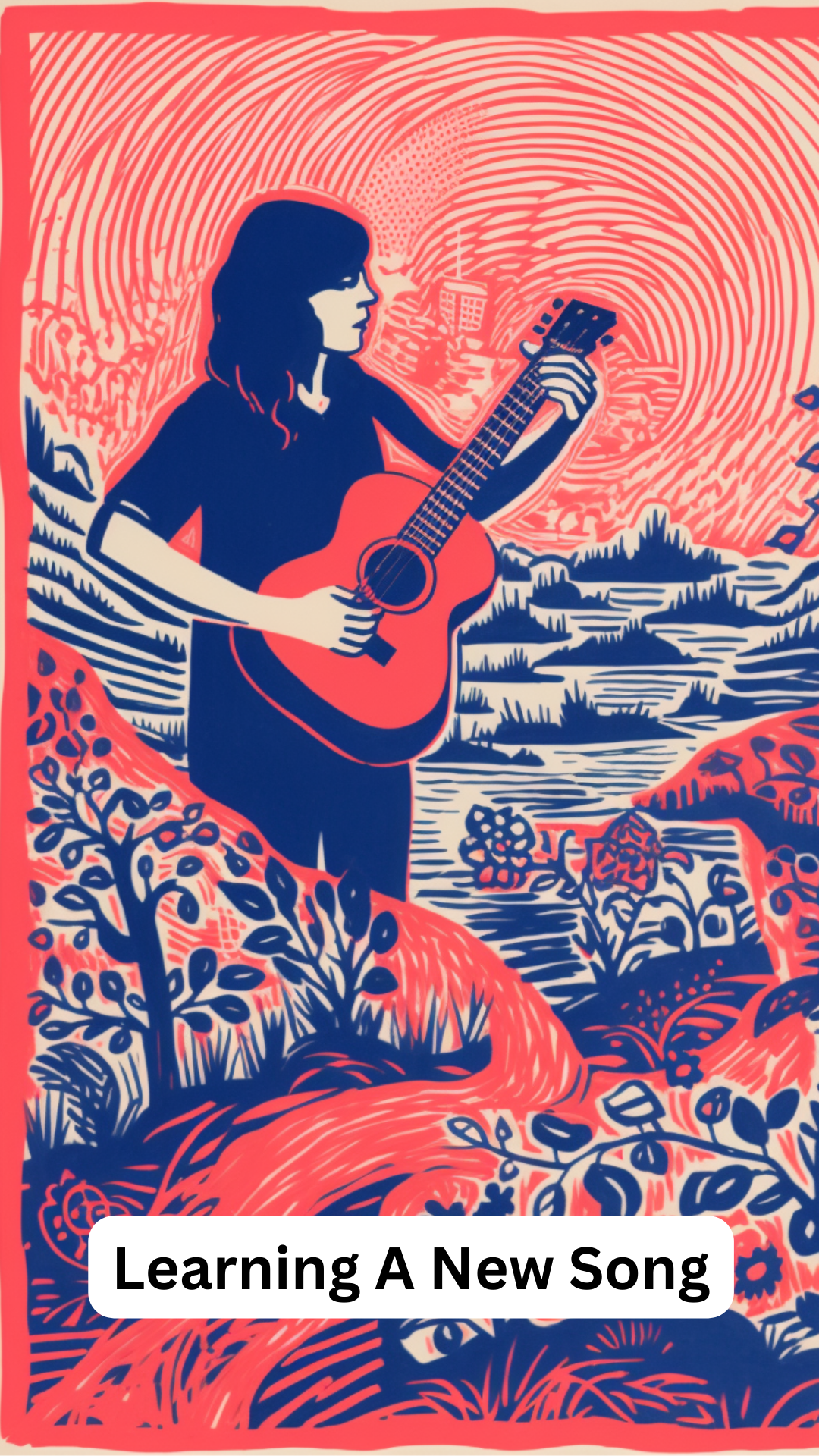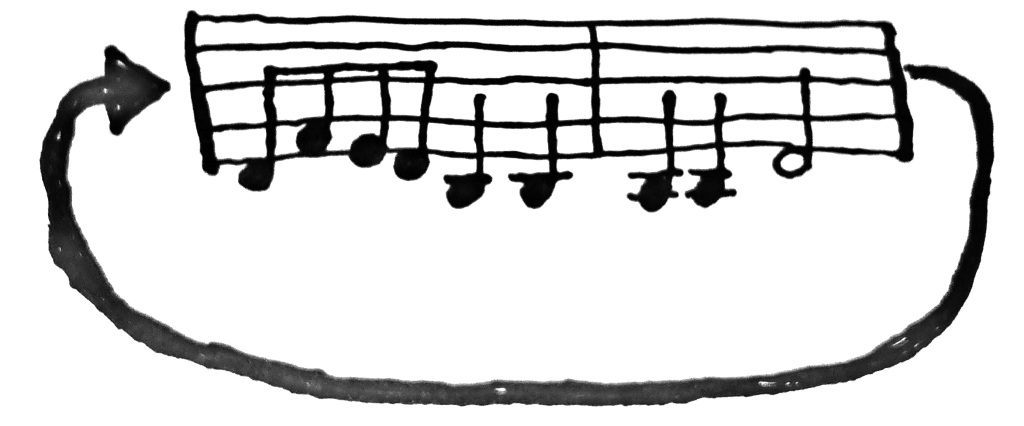Learn-A-Song Journey
This “practice journey” can be used to learn any new song, regardless of skill level. Whether you’re a beginner working on Twinkle, Twinkle Little Star or a more advanced player adding variation to Wagon Wheel, I encourage you to apply this to songs you’re currently learning.
Note: I use “Song” as a general term for “tune”, “piece”, “repertoire” etc.
Follow the brief outline below. See the “Rabbit Hole” tabs below that if you need to know about a particular strategy or want to see examples.
Tutorial
Here’s a tutorial using a song called Hesitation Blues. See the tab below for more details on this particular song.

1. Warm Up ☀️
Warm up with a single note using a drone track or metronome. Let the body relax, enjoying the sound. Then play the scale for the song. Add simple variations: Rhythms, Texture and Volume.
2. Listen 🎧
Listen to the whole song. Then listen to the beginning a few times.
3. Chain 🔗
Play the first note, the first two notes, continuing until you have the first musical Chunk.
4. Slow Down 🐢
Pay attention to the motions as you play that Chunk. Make small adjustments so that the hands reach their destination with ease.
5. Loop 🔁
Play this chunk in a continuous Loop. Let it groove and flow as if it’s a complete melody.
6. Sing 🗣️
Sing the first Chunk. Alternate between singing and playing the first phrase (either the lyrics or non-lyrical vocals like “na” and “la”).
7. Memorize 🧠
Play the first Chunk until it’s memorized.
8. Repeat 🔄
Repeat steps 2-7 for the next chunk of the song.
9. Chain the Chunks 🔗
Chain the first two Chunks into a bigger piece. Repeat steps 2-9 until you have the whole song. Work on the transitions between parts.
10. Record & Reflect 🎙️ 📝
Make a short audio recording (1-2 minutes) after each session. It doesn’t have to be the full tune. Perhaps you just record a loop of the hardest part. Listen to it right after you record it.
Then ask yourself, “What has improved? What still needs work?” Take note of this in your practice journal.
Take A Small Step 🥾
You don’t have to learn the entire song in one go. Focus on mastering small segments. Celebrate each small step.
Rabbit Hole 🐇
Below you’ll find more in-depth teaching on the different steps of this practice journey. You can also see examples of how to apply this to songs (beginner and intermediate).
I recommend referring to the tabs below if you’re stuck or have questions. If you already understand the strategies, then focus on practicing and enjoying the music!
Chaining and Chunking 🔗🧩
Here’s how to play the Chain Game to learn songs:
- Play the first note.
- Then play the first two notes.
- Continue until you have a Chunk of music that you can easily repeat.
- Loop on that Chunk.
- Then repeat the Chain game on the next Chunk.
- Once you have that second Chunk, then Chain the two chunks together.
- Repeat the Process until you can play the whole song.

Reverse the process
You can take any song and break it into Chunks. Then use chaining to practice difficult sections.

Looping 🔁
Take a small musical chunk and play it continuously. In this way you move from thinking to playing.
Start Small 🌱
Identify a Chunk that needs some love. Practice it with single repetitions. Between each rep, take a moment to breathe, adjust, and get ready to play it again.
Once you can do that reasonably well, then play it in a continuous Loop. Find a tempo that flows.
Feel the groove of this. Imagine that it’s a tiny song.
Repeat the Process for other chunks of different sizes.
Loop Alert: Watch Out for Those Mistakes! 🚫
If you stumble, then pause to adjust. When you practice a mistake you get really good at playing a mistake 👎. Try these changes to get on track:
- Go Slow: Dial down the tempo.
- Mini Loops: Shrink your loop to a more manageable size. Sometimes two notes form the perfect loop.
- Back to Basics: Return to single reps to regain your confidence.

Instead of going through the motions, Looping helps it to sound like music.
Play Slowly
Go Ridicu-Slow 🐢
If you can’t play something, chances are you’re going too fast. Speeding leads to anxious hands and a cluttered mind. 🤯
Slow down to overcome almost any obstacle. 🧗🏾♂️
Ridicu-Slow Chunks 🕰️
Pick a challenging Chunk of a song or exercise. Play it once at a snail’s pace. Continue to play single reps.
As you practice, allow the body and breath to be calm. Focus your attention on the movement of your hands. Let your fingers reach their destination with ease.
If necessary, practice the motions without even making sound.
At some point do you notice a feeling of relief?
Loop 🔁
Once you can play the chunk slowly with ease, then Loop it continuously. Maintain that sense of ease in your body.
Slow 🔁 Medium 🚶🏿
Then, allow yourself to naturally speed up to a medium tempo. Do you notice tension? Where is it happening? Pause. Turn your attention to that part of your body and play slowly again.
Keep alternating between ridicu-slow and medium, pausing to focus on smaller chunks if necessary.

Sing 🗣️
In this game, you’ll develop your ear and your ability to pick up new songs.
La, La, La 🦜
1. Pick a scale or a little song-chunk and play it on your instrument.
2. Sing the same melody with the lyrics or “La,” “Do,” etc. (whatever sound feels right). Adjust octave to fit your vocal range. If you struggle, then try to sing just one note.
3. Use Single Reps to alternate between playing and singing.
4. Take it up a notch with a continuous Loop.
5. Repeat on other smaller and bigger chunks. Eventually sing then play the whole song.
Pro Tips 💡
Learn the lyrics, even if you’re not “officially” a singer.
Experiment with voice Textures.
Alternate voices. In addition to singing, you can hum, whistle or play the melody on a different instrument. This is good for people who super-self conscious about singing. Using a different voice will strengthen the mental model of the melody.
Remember ☝️
When you sing what you play, the instrument becomes an extension of your voice. Along the way you may unlock the ability to play an instrument you were born with 👶🏽
Memorize 🧠
Memorize as you go.
Learn the first Chunk of a new song using Chaining, Looping and Singing.
Close Your Eyes and play it. Then pause to Visualize yourself playing it. Can you hear the music without playing?
Keep going until it’s memorized.
Do something different for a minute (like a scale or a different short tune). Then return to that first Chunk.
Repeat the Process for each Chunk of the song.
Make it a Habit to do this every time you learn new music.
Example 1: Freres Jacques
Let’s play the Chain Game to learn Freres Jacques.
Play the first note: D0
Then play the first two notes: D0-1
Continue Chaining until you have a Chunk of music that you can easily repeat: D0-1-2-0
Loop on that Chunk.
Then repeat the Chain game on the next Chunk: D2-3-A0
Once you have that second Chunk, then Chain the two chunks together:
D0-1-2-0 | D0-1-2-0 | D2-3-A0 | D2-3-A0
Repeat The Process
Play this fun game on any song you learn.
Full lesson here: Freres Jacques
Example 2: When The Saints Go Marching In (Beginner)
Take a full workshop on this here (subscribers only).
Example 3: Little Liza Jane
If you want to learn a new song, Then don’t try to play the whole thing right away.
Break it down into small manageable Chunks.
Let’s really learn the first bar D2-2-2-1-0-2-A0-1-0.
Maybe you discover the hardest Chunk within that is D2-A0-1-0
Then Go Slow with single reps, giving your fingers time to reach their destination.
When it feels comfortable, Loop that chunk
Repeat the process with the other Chunks.
Then, Chain the Chunks together into larger parts.
Full lesson here: Little Liza Jane
Example 4: Wagon Wheel
If you want to play a song like Wagon Wheel…
Start by warming up with its scale, A Major: A0-1-2-3-E0-1-2-3 | G1-2-H3-D0-1-2-H3-A0
Then learn the first Chunk by Chaining a few notes at a time.
D1-2-A0-1
D1-2-A0-1-1-2-2
Learn the next Sub-Chunk: A3-{2-3-2}-2-1
Then Chain the Chunks: D1-2-A0-1-1-2-2-3-{2-3-2}-2-1.
Loop this bigger Chunk.
Repeat the Process on other Chunks until you have the whole song.
Example 5 : Learning Hesitation Blues (Intermediate)
Specific notes for learning Hesitation Blues
Take a full workshop on this here (subscribers only).
Start by getting into a Small Steps, Small Wins mindset. You don’t have to learn the entire song in one go. Focus on mastering small segments.
Warm up with the scale for the song. For Hesitation Blues it’s A Major Blues.
Use an A Drone this song.
Listen to the song. If possible to the exact version you’ll be learning.
Next, Chain the first few notes. Keep going until you have the whole first bar.

Play it once and notice if you stumble anywhere.
For example, E0-A2 might be sloppy. So Focus on Movement as you practice that bit. Drill down on any other hard parts in that Chunk.
Once you have this chunk, slowly Loop it.
Embed this first part into your brain as a Mental Trigger. by saying the title and then playing the first chunk. For example, say “Hesitation Blues” and then play the first chunk. This will help you recall the tune later on.
Extract the Rhythm When faced with a tricky rhythm, simplify things by playing it on a single note. Go deeper by clapping or chanting the rhythm.
Once you master the first chunk, use the same process for the remaining chunks of the song.
Learn more here: Hesitation Blues Workshop (for paid subscribers)
Now take this routine, apply it to whatever tune you’re learning and go fiddle with it on your own.
Further learning
Mix Up Your Music Practice With Interleaving
Here are some workshops for paid subscribers in which we dive deep into this process:
It Came Upon A Midnight Clear Workshop
Customize this process to your needs. You may find other strategies that work for you when learning new songs. Or you might need to adjust your approach to learn a particular song.
Two ways I can help you on your fiddle journey 🎻
- Sign up for the Free Two-week Trial. You’ll get full access to all courses and group lessons. Plus, I’ll send you some free lessons tailored to your current skill level.
- Sign up for the FiddleHed newsletter below, then get high-value tips and lessons delivered to your inbox.
Improve A Song Journey
Once you get to the point where you can play through a song, then let it incubate for a few days or a week. Work on other skills, review or even a new song. Having that little bit of time off will help you learn it more deeply. This learning strategy is called Spaced Repetition.
Then return to this song and refine it using the Improve-A-Song Journey.

